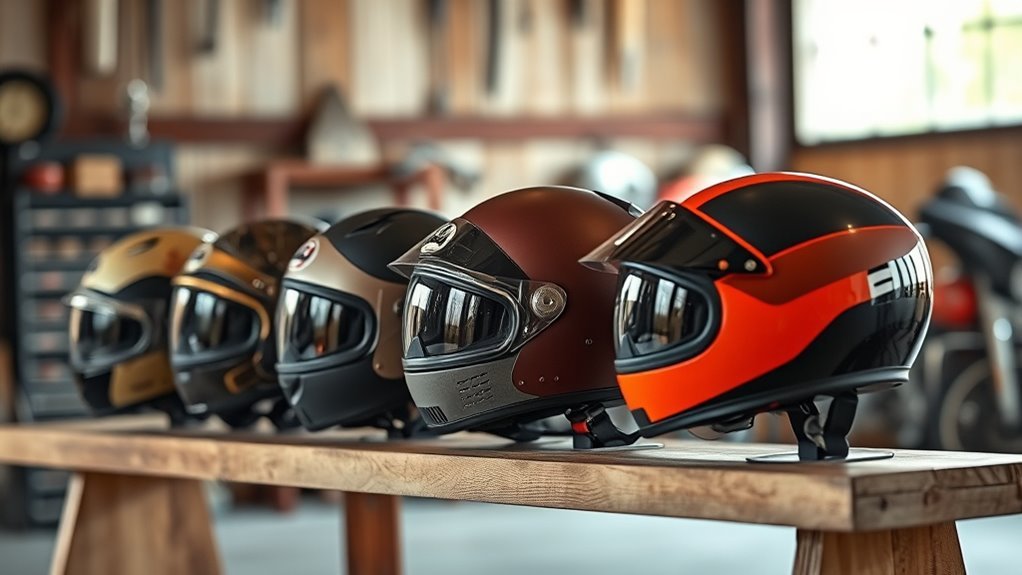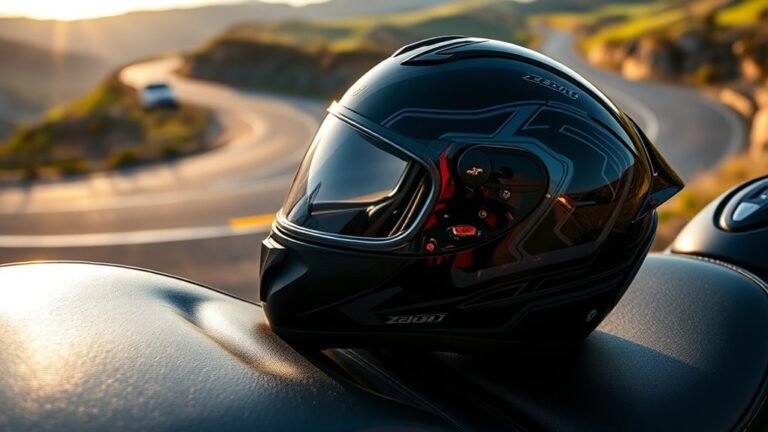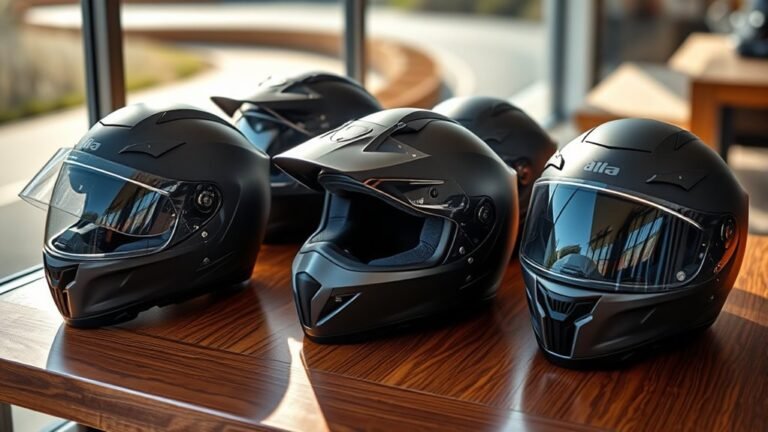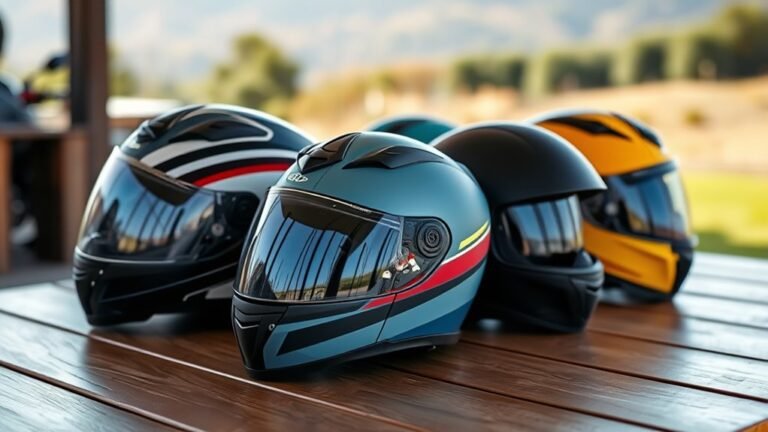The History of Motorcycle Helmets: From Past to Present
The history of motorcycle helmets tracks a significant evolution from basic leather caps to modern, high-tech safety gear. Initially prioritized for style over safety, helmets transformed in the 1970s with standardized regulations aimed at protecting riders. Innovations in materials, such as carbon fiber, and designs like modular and full-face helmets enhanced protection and comfort. Today’s helmets integrate smart technology for improved safety and communication, illustrating a journey that continues to adapt to rider needs and preferences. There’s much more to explore.
The Early Days of Motorcycle Helmets
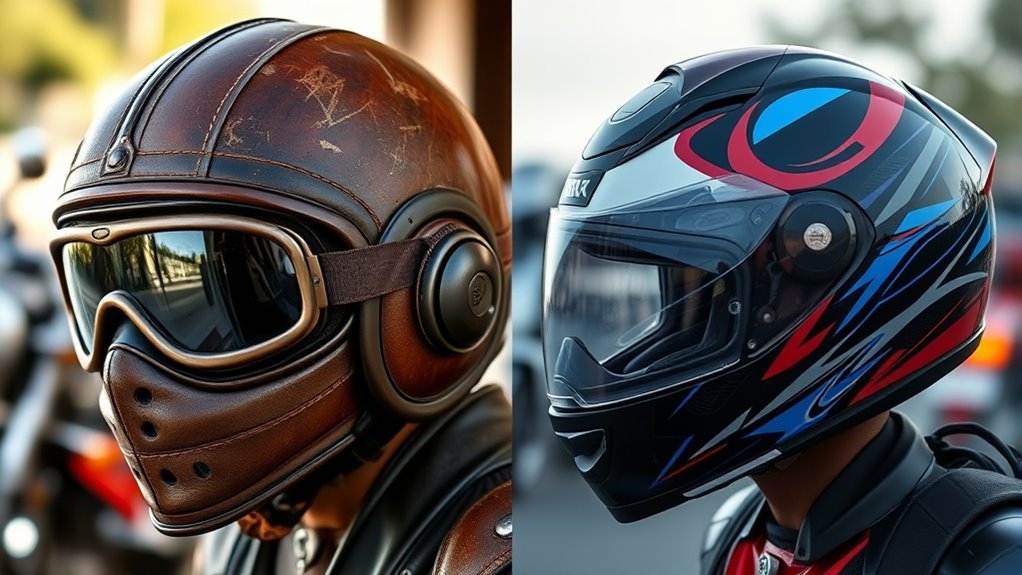
In the early days of motorcycle helmets, safety was often an afterthought rather than a priority. Riders typically donned leather caps, which offered minimal protection—largely a nod to style rather than function. These caps, stemming from racing origins, were designed to keep wind and debris at bay, but they did little to protect against serious injuries. As motorcycle culture grew, so did the recognition of the need for better headgear. Riders, seeking freedom on the open road, began to question the efficacy of their gear. This desire for enhanced safety gradually paved the way for innovations in helmet design, emphasizing the balance between maintaining that spirit of freedom while prioritizing rider protection. Hence, the evolution of motorcycle helmets began.
The First Standardized Helmets
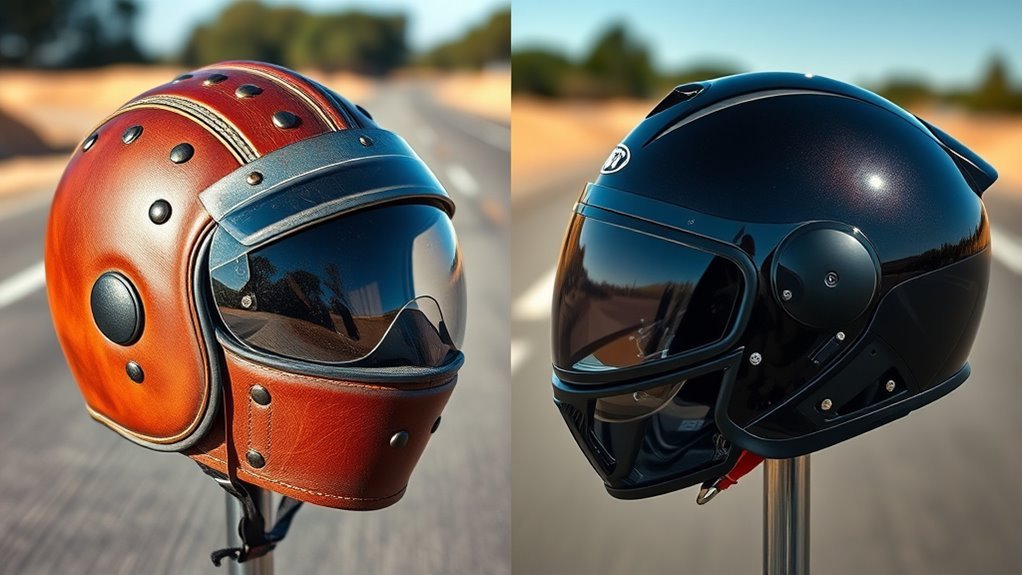
As the motorcycle community recognized the inadequacies of leather caps, the push for improved safety led to the creation of the first standardized helmets. These helmets emerged in response to growing concerns about rider safety and the increasing number of accidents. The first regulations were established in the 1970s, setting the groundwork for helmet standards that manufacturers had to meet. These standards aimed to guarantee that helmets provided adequate protection without sacrificing comfort. Riders began to embrace these innovations, valuing safety alongside their cherished freedom on the open road. The introduction of standardized helmets marked a significant shift in motorcycle culture, blending the thrill of riding with a newfound commitment to safety, ultimately enhancing the riding experience for everyone.
Innovations in Materials and Design
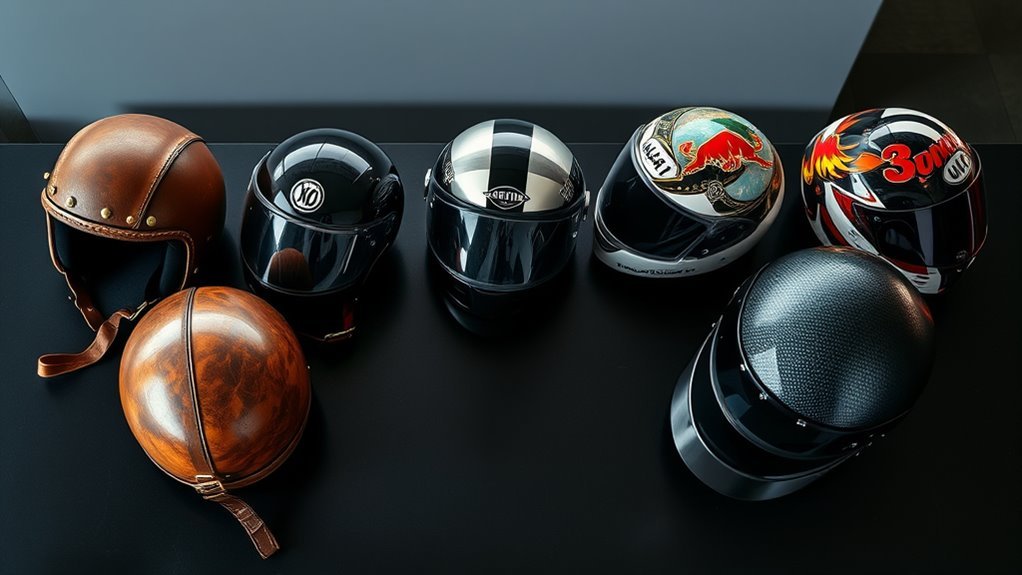
While the introduction of standardized helmets was a crucial step in motorcycle safety, innovations in materials and design have further revolutionized helmet technology. Today, helmets made from advanced composites, such as carbon fiber and Kevlar, offer enhanced durability without compromising weight. These materials provide better impact resistance, ensuring you’re protected during your rides. Furthermore, ergonomic designs have transformed how helmets fit, allowing for improved comfort and reduced fatigue on long journeys. Features like adjustable ventilation and integrated communication systems cater to the freedom-loving rider, enhancing the overall experience. As manufacturers continue to push boundaries, these innovations not only prioritize safety but also embrace the spirit of adventure that every motorcyclist seeks. Your helmet can now be both protective and comfortable, elevating your ride.
The Role of Safety Regulations
Safety regulations have greatly shaped the evolution of motorcycle helmets, starting from early guidelines that aimed to protect riders. Modern safety standards, such as those established by organizations like DOT and Snell, continue to influence helmet design, ensuring enhanced protection and performance. Understanding these regulations reveals their essential role in promoting rider safety and innovation in helmet technology.
Early Regulations Overview
Regulations surrounding motorcycle helmets emerged from a growing recognition of the dangers associated with riding. As the number of accidents increased, so did the call for helmet legislation, aimed at protecting riders. Safety advocacy groups played a vital role, pushing for laws that mandated helmet use to reduce fatalities and serious injuries. These early regulations sought to balance personal freedom with the undeniable need for safety. While some riders viewed these laws as intrusive, advocates argued that they were essential in promoting responsible riding behavior. By establishing minimum safety standards for helmets, early regulations laid the groundwork for a culture prioritizing rider protection, ultimately influencing public perception and legislation surrounding motorcycle safety for decades to come.
Modern Safety Standards
As the motorcycle industry evolved, so did the need for stringent safety standards to protect riders effectively. Modern testing protocols have emerged, ensuring that helmets undergo rigorous evaluations to meet these standards. Organizations like the Department of Transportation (DOT) and the Snell Memorial Foundation set benchmarks that promote safety advancements in helmet design.
Here are some key aspects of modern safety regulations:
- Helmets must pass impact and penetration tests.
- Testing procedures evaluate retention systems and field of vision.
- Standards are regularly updated to reflect new technologies.
- Compliance with regulations is essential for market access.
These regulations not only enhance rider safety but also empower you to ride with confidence, knowing you’re protected by the latest advancements in helmet technology.
Impact on Helmet Design
The evolution of helmet design is largely shaped by the rigorous safety standards established by organizations like the DOT and Snell Memorial Foundation. These regulations push manufacturers to prioritize safety advancements, leading to helmets that not only protect but also enhance your riding experience. As you embrace the freedom of the open road, you’ll appreciate how design evolution has fostered lighter materials, improved aerodynamics, and better ventilation. These innovations guarantee that while you enjoy your ride, safety remains paramount. Compliance with safety regulations has led to helmets that balance protection and comfort, allowing you to ride confidently. The impact of these standards on helmet design is profound, guaranteeing every journey is both exhilarating and secure.
The Impact of Crash Test Standards
While many riders may not realize it, crash test standards play a crucial role in ensuring the safety and effectiveness of motorcycle helmets. These standards are built on rigorous crash test methodologies that assess helmet safety performance, giving you confidence in your gear.
- They establish minimum safety requirements for helmets.
- They help manufacturers improve helmet designs.
- They provide reliable information for consumers when choosing a helmet.
- They encourage innovation in safety technology.
The Rise of Modular and Full-Face Helmets
With the increasing popularity of modular and full-face helmets, riders are finding themselves better protected without sacrificing comfort or convenience. Modular features, such as flip-up visors and removable chin bars, offer a unique blend of versatility, allowing you to easily shift between open and closed face styles. This adaptability is perfect for those who crave freedom on the road but also want the security that full-face advantages provide. Full-face helmets shield your entire head, enhancing protection in a crash while minimizing wind noise and distractions. As you explore the options, you’ll notice how these designs cater to both safety and the desire for an open riding experience—a balance that modern motorcyclists increasingly embrace.
Integration of Technology in Helmets
As technology advances, motorcycle helmets are evolving beyond mere safety gear into sophisticated devices that enhance the riding experience. Smart helmets are at the forefront of this transformation, integrating features like Bluetooth connectivity and built-in speakers for seamless communication. Augmented reality displays provide real-time navigation and crucial information directly in your line of sight, allowing you to keep your focus on the road.
Motorcycle helmets are transforming into smart devices, merging safety with advanced features for an enhanced riding experience.
Consider these exciting features:
- Bluetooth connectivity for hands-free communication
- Noise-cancellation technology for a quieter ride
- Heads-up displays for navigation and speed
- Crash detection systems that alert emergency services
With these innovations, you can enjoy the open road while staying connected and informed, redefining what it means to ride freely.
The Future of Motorcycle Helmet Safety
As motorcycle safety continues to evolve, smart technology integration is becoming a key focus for future helmet designs. These advancements aim to enhance impact resistance and provide real-time data to riders, potentially reducing accident severity. You’ll want to contemplate how these innovations could transform your riding experience and safety on the road.
Smart Technology Integration
While traditional motorcycle helmets have primarily focused on impact protection, the integration of smart technology is revolutionizing safety measures and rider experience. Today’s helmets are equipped with smart connectivity and helmet sensors, enhancing your ride in unprecedented ways.
- Real-time data monitoring for essential signs
- Navigation assistance through voice commands
- Accident detection and emergency alerts
- Integration with smartphones for seamless communication
These advancements not only offer improved safety but also allow you to stay connected while enjoying the freedom of the open road. As you embrace these innovations, you’ll find that riding becomes not just about the thrill, but also about a smarter, safer journey. The future of motorcycle safety is here, and it’s making your ride even more exhilarating.
Enhanced Impact Resistance
With advancements in materials and design, motorcycle helmets are set to achieve unprecedented levels of impact resistance, markedly enhancing rider safety. The future of helmet technology focuses on innovative materials like carbon fiber and advanced polymers that improve helmet durability while optimizing impact absorption. These materials not only disperse energy efficiently during an impact but also maintain structural integrity, ensuring long-term reliability. As manufacturers experiment with multi-layer designs and progressive density foams, you can expect helmets that adapt to various impact scenarios. This evolution in helmet safety is essential for those who seek the thrill of the ride, providing peace of mind without sacrificing freedom. By prioritizing enhanced impact resistance, you’re investing in your safety and riding experience.
Frequently Asked Questions
How Do I Choose the Right Motorcycle Helmet Size?
To choose the right motorcycle helmet size, you’ll need to focus on helmet fitting. Start by measuring your head circumference just above your eyebrows. Then, consult a sizing guide from the helmet manufacturer, as sizes can vary. Make sure the helmet fits snugly without pressure points, and it shouldn’t move when you shake your head. Remember, a proper fit enhances your safety and comfort, allowing you the freedom to ride confidently.
What Is the Lifespan of a Motorcycle Helmet?
A motorcycle helmet’s lifespan is often likened to a fleeting moment of freedom—typically around five years. This durability reflects the evolving safety standards meant to protect you on the open road. Over time, materials degrade, impacting performance in a crash. Regular inspections are essential; if you notice any signs of wear or damage, it’s time to retire it. Remember, your helmet’s integrity is the shield that safeguards your adventurous spirit.
Are Expensive Helmets Worth the Investment?
Yes, expensive helmets are worth the investment. They often come with enhanced safety features like better impact resistance and improved ventilation, which can make a significant difference in an accident. Comfort factors, such as padding and weight distribution, also play a vital role in your riding experience. When you’re out on the road, having a helmet that combines safety and comfort allows you to focus on the freedom of the ride without distractions.
Can Helmets Be Recycled After Use?
Yes, helmets can be recycled after use, but it depends on the materials and local recycling programs. Helmet recycling helps reduce their environmental impact by preventing waste in landfills. Many manufacturers are now focusing on sustainable designs, which makes it easier for you to contribute to eco-friendly practices. When you’re done with your helmet, check with local facilities to guarantee you’re recycling properly and doing your part for the planet.
How Often Should I Replace My Motorcycle Helmet?
You should replace your motorcycle helmet every 3 to 5 years, even if it looks fine. Over time, materials degrade, impacting helmet safety standards. Additionally, if you’ve been in an accident, even a minor one, it’s essential to replace your helmet immediately, as its protective capabilities may be compromised. Staying updated with helmet replacement frequency guarantees you maintain the freedom of the open road while prioritizing your safety.
